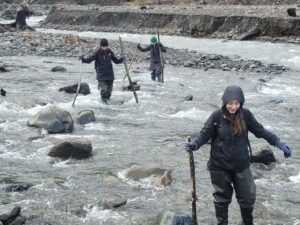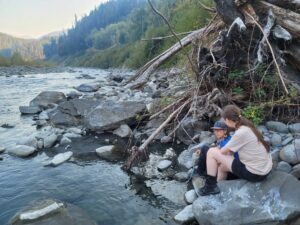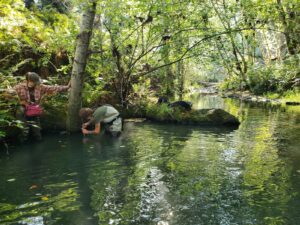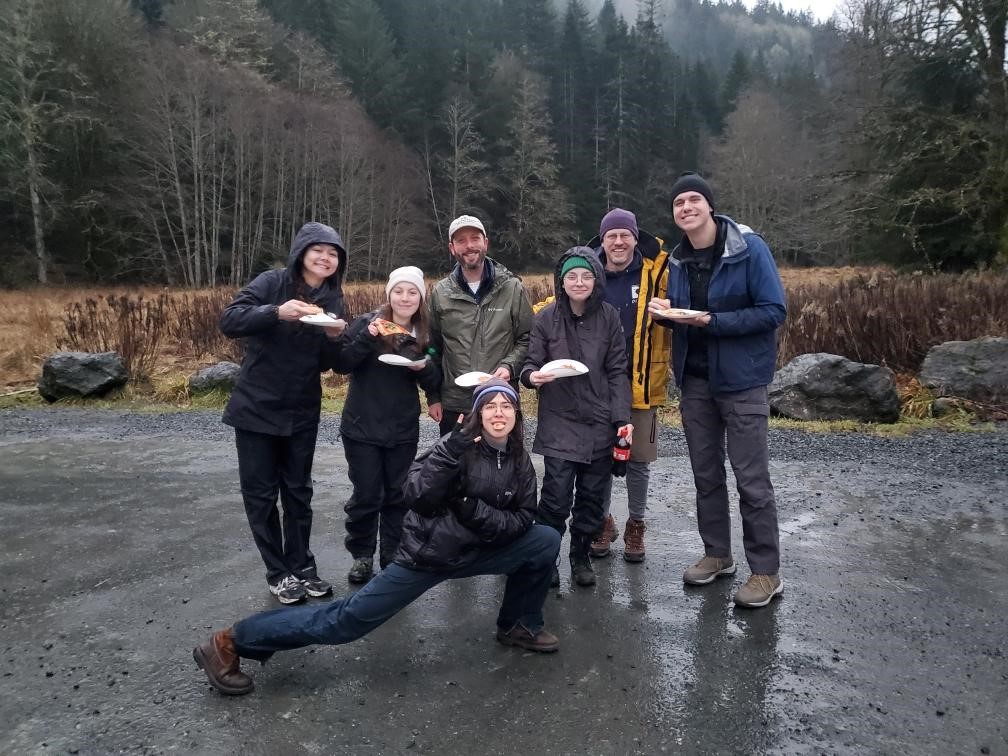Long-term Elwha River Temperature Monitoring Depends on Enduring Partnerships
Text and photos by: Chelsea Behymer & Sarah Morley
On a soggy Saturday morning in January, a group of Environmental Science and Civil Engineering undergraduate students from Seattle University are greeted by NOAA research ecologist Sarah Morley at the Olympic National Park boundary gate adjacent to the Elwha River. The parking lot where they are gathered is the furthest point that can be driven upriver since the Olympic Hot Springs access road began flooding in 2015 and eventually gave way to the river’s reclamation of its historic channels.
From there, the group will split their efforts and venture above and below the former Glines Canyon dam site to access temperature monitoring instruments in the riverbed. These so-called ‘temperature loggers’ are set to record water temperature every hour and are capable of storing over five years of data. In October of last year, through NOAA and SU colleague connections, professor Wes Lauer brought six students to the Elwha to help Morley maintain existing loggers and install new ones. This field trip, a different group of students (aside from one repeat volunteer!) return to these sites to download the dataset.

Some instruments are more accessible than others. This field trip, SU students were grateful the cold temperatures and little prior rainfall contributed to a relatively low water crossing of Boulder Creek to access the logger located in what was once Lake Mills. Still, the group benefited from waders, sturdy footwear, trekking poles and a sense of adventure.
The idea is that at regular intervals (every 3 months if possible, to ensure the loggers are still in the correct location) the information each sensor has been gathering and storing will be downloaded by researchers or volunteers onto a cell phone application. The data in these files is then added to an online database to keep a long-term record of changes over time since dam removal.
Aquatic species, such as salmon and macroinvertebrates, are temperature-sensitive; capturing patterns and trends helps inform management decisions and ecological research in the context of a recovering river system. Having high-resolution stream temperature data can help managers assess where conditions are currently or may become too warm to be habitable, as well as where conditions may provide thermal refuge (i.e. cool water!) in the heat of summer. This information is also really helpful in understanding how fish distribute themselves in the river at different life stages and how fast they grow.

NOAA research ecologist Sarah Morley works with SU Environmental Science student Amanda Blunt to install a temperature sensor on the banks of the Elwha River in October 2022.
Lauer has been involved in Elwha-related research since before the removals began, supporting planning and prediction modeling. It is these long-term relationships among researchers, education institutions and volunteer organizations that have made many of the long-term monitoring efforts possible on the Elwha River after the dams were removed. The Lower Elwha Klallam Tribe and their Natural Resources Department has been at the heart of many of these collaborations.

LEKT Natural Resources technicians McKenzi Taylor and Gabe Ritchie download data on a temperature logger installed in a tributary to the Elwha, critical salmon rearing habitat.
LEKT Natural Resources, NOAA’s Watershed Program, and other partners have collected water temperature data on the river for over 20 years, but more data is needed to build a complete picture and predictive model. In order to fill in the gaps and continue adding to this temperature database, Morley and colleagues are hoping to recruit other volunteer groups to ‘adopt a logger’ and take on the responsibility of regularly checking instruments at other sites in the watershed.
These recent contributions by Seattle University students is just one of the new collaborations in support of this overall effort.
“The most valuable part of the experience for students is the ability to get into the field and see what a real data collection project looks like. It’s way too easy for students to spend four (or more) years studying the environment without ever experiencing it. I also think that shared projects like this build a sense of community that is really valuable for our students, particularly those who are still settling into the university experience.”
– Wes Lauer, Ph.D., Seattle University Associate Professor & Director of Environmental Science
NOAA Fisheries Biologist Aimee Fullerton is currently developing a platform where this temperature data can be uploaded and immediately input to generate and update publicly-available temperature graphs, so this research can be more easily accessible to a wider audience and also available to other researchers working in the Elwha watershed. A pilot version of this data portal is now available, and NOAA is seeking input on how to make this platform as user friendly as possible.
These field days are rewarding for researchers and volunteers alike – a time to connect with each other, contribute to environmental science and celebrate the successes of the day, as well as those of a locally-based restoration effort with big-picture implications.
“It was a wonderful day collecting data and getting to know the research scientist (Sarah) involved with the project.”
– Amanda Blunt, Seattle University Environmental Science student

